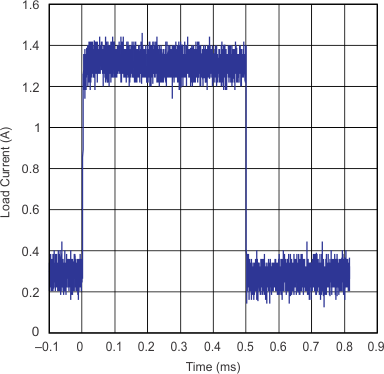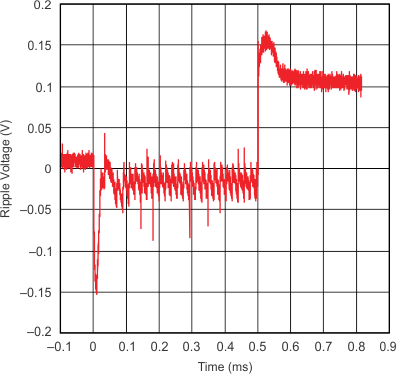SLVS569F January 2005 – August 2015 LM2575
PRODUCTION DATA.
- 1 Features
- 2 Applications
- 3 Description
- 4 Revision History
- 5 Pin Configuration and Functions
- 6 Specifications
- 7 Detailed Description
-
8 Application and Implementation
- 8.1 Application Information
- 8.2
Typical Application
- 8.2.1 Design Requirements
- 8.2.2
Detailed Design Procedure
- 8.2.2.1 Input Capacitor (CIN)
- 8.2.2.2 Output Capacitor (COUT)
- 8.2.2.3 Catch Diode
- 8.2.2.4 Inductor
- 8.2.2.5 Output Voltage Ripple and Transients
- 8.2.2.6 Feedback Connection
- 8.2.2.7 ON/OFF Input
- 8.2.2.8 Grounding
- 8.2.2.9 Reverse Current Considerations
- 8.2.2.10 Buck Regulator Design Procedure
- 8.2.2.11 Inductor Selection Guide
- 8.2.3 Application Curves
- 9 Power Supply Recommendations
- 10Layout
- 11Device and Documentation Support
- 12Mechanical, Packaging, and Orderable Information
8 Application and Implementation
NOTE
Information in the following applications sections is not part of the TI component specification, and TI does not warrant its accuracy or completeness. TI’s customers are responsible for determining suitability of components for their purposes. Customers should validate and test their design implementation to confirm system functionality.
8.1 Application Information
The limited component count and internal frequency compensation makes the LM2575 easy use. Output voltage is set by two external resistors.

where
- VREF = 1.23 V
8.2 Typical Application
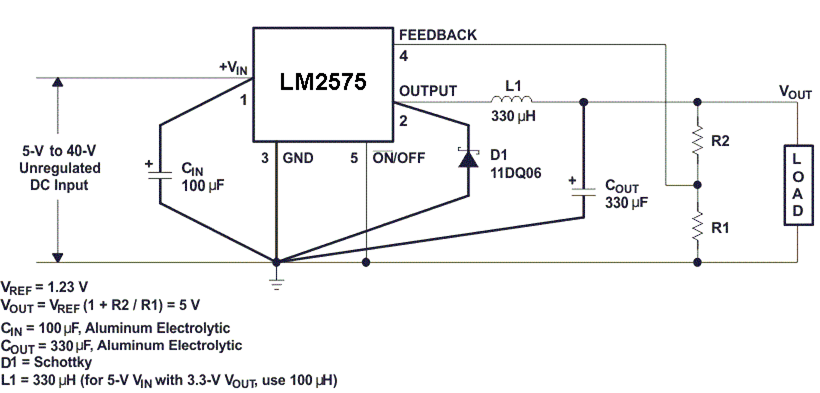 Figure 11. Buck Regulator With User Programmable Output Voltage
Figure 11. Buck Regulator With User Programmable Output Voltage
8.2.1 Design Requirements
Output voltage is set by R1 and R2. Output voltage must be between VREF and (VIN[minimum] – VSAT) × Duty Cycle [maximum].
VSAT maximum and duty cycle maximum are specified in the Electrical Characteristics table.
8.2.2 Detailed Design Procedure
8.2.2.1 Input Capacitor (CIN)
For stability concerns, an input bypass capacitor (electrolytic, CIN ≥ 47 μF) must be located as close as possible to the regulator. For operating temperatures below –25°C, CIN may need to be larger in value. In addition, because most electrolytic capacitors have decreasing capacitances and increasing ESR as temperature drops, adding a ceramic or solid tantalum capacitor in parallel increases the stability in cold temperatures.
To extend the capacitor operating lifetime, the capacitor RMS ripple current rating should be:
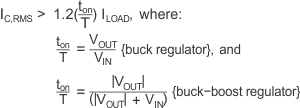
8.2.2.2 Output Capacitor (COUT)
For both loop stability and filtering of ripple voltage, an output capacitor also is required, again in close proximity to the regulator. For best performance, low-ESR aluminum electrolytics are recommended, although standard aluminum electrolytics may be adequate for some applications::
Output ripple of 50 mV to 150 mV typically can be achieved with capacitor values of 220 μF to 680 μF. Larger COUT can reduce the ripple 20 mV to 50 mV peak-to-peak. To improve further on output ripple, paralleling of standard electrolytic capacitors may be used. Alternatively, higher-grade capacitors such as “high-frequency”, “low-inductance”, or “low-ESR” can be used.
The following should be taken into account when selecting COUT:
- At cold temperatures, the ESR of the electrolytic capacitors can rise dramatically (typically 3× nominal value at –25°C). Because solid tantalum capacitors have significantly better ESR specifications at cold temperatures, they must be used at operating temperature lower than –25°C. As an alternative, tantalums also can be paralleled to aluminum electrolytics and must contribute 10% to 20% to the total capacitance.
- Low ESR for COUT is desirable for low output ripple. However, the ESR should be greater than 0.05 Ω to avoid the possibility of regulator instability. Hence, a sole tantalum capacitor used for COUT is most susceptible to this occurrence.
- The capacitor’s ripple current rating of 52 kHz should be at least 50% higher than the peak-to-peak inductor ripple current.
8.2.2.3 Catch Diode
As with other external components, the catch diode must be placed close to the output to minimize unwanted noise. Schottky diodes have fast switching speeds and low forward voltage drops and, thus, offer the best performance, especially for switching regulators with low output voltages (VOUT < 5 V). If a high-efficiency, fast-recovery, or ultra-fast-recovery diode is used in place of a Schottky, it must have a soft recovery (versus abrupt turnoff characteristics) to avoid the chance of causing instability and EMI. Standard 50-/60-Hz diodes, such as the 1N4001 or 1N5400 series, are NOT suitable.
8.2.2.4 Inductor
Proper inductor selection is key to the performance-switching power-supply designs. One important factor to consider is whether the regulator will be used in continuous (inductor current flows continuously and never drops to zero) or in discontinuous mode (inductor current goes to zero during the normal switching cycle). Each mode has distinctively different operating characteristics and, therefore, can affect the regulator performance and requirements. In many applications, the continuous mode is the preferred mode of operation, because it offers greater output power with lower peak currents, and also can result in lower output ripple voltage. The advantages of continuous mode of operation come at the expense of a larger inductor required to keep inductor current continuous, especially at low output currents and/or high input voltages.
The LM2575 can operate in either continuous or discontinuous mode. With heavy load currents, the inductor current flows continuously and the regulator operates in continuous mode. Under light load, the inductor fully discharges and the regulator is forced into the discontinuous mode of operation. For light loads (approximately 200 mA or less), this discontinuous mode of operation is perfectly acceptable and may be desirable solely to keep the inductor value and size small. Any buck regulator eventually operates in discontinuous mode when the load current is light enough.
The type of inductor chosen can have advantages and disadvantages. If high performance or quality is a concern, then more-expensive toroid core inductors are the best choice, as the magnetic flux is contained completely within the core, resulting in less EMI and noise in nearby sensitive circuits. Inexpensive bobbin core inductors, however, generate more EMI as the open core does confine the flux within the core. Multiple switching regulators located in proximity to each other are particularly susceptible to mutual coupling of magnetic fluxes from each other’s open cores. In these situations, closed magnetic structures (such as a toroid, pot core, or E-core) are more appropriate.
Regardless of the type and value of inductor used, the inductor never should carry more than its rated current. Doing so may cause the inductor to saturate, in which case the inductance quickly drops, and the inductor looks like a low-value resistor (from the DC resistance of the windings). As a result, switching current rises dramatically (until limited by the current-by-current limiting feature of the LM2575) and can result in overheating of the inductor and the IC itself.
NOTE
Different types of inductors have different saturation characteristics.
8.2.2.5 Output Voltage Ripple and Transients
As with any switching power supply, the output of the LM2575 has a sawtooth-ripple voltage at the switching frequency. Typically about 1% of the output voltage, this ripple is due mainly to the inductor sawtooth-ripple current and the ESR of the output capacitor (see note on COUT). Furthermore, the output also may contain small voltage spikes at the peaks of the sawtooth waveform. This is due to the fast switching of the output switch and the parasitic inductance of COUT. These voltage spikes can be minimized through the use of low-inductance capacitors.
There are several ways to reduce the output ripple voltage: a larger inductor, a larger COUT, or both. Another method is to use a small LC filter (20 μH and 100 μF) at the output. This filter can reduce the output ripple voltage by a factor of 10 (see Figure 16).
8.2.2.6 Feedback Connection
FEEDBACK must be connected between the two programming resistors. Again, both of these resistors should be in close proximity to the regulator, and each should be less than 100 kΩ to minimize noise pickup.
8.2.2.7 ON/OFF Input
ON/OFF should be grounded or be a low-level TTL voltage (typically <1.6 V) for normal operation. To shut down the LM2575 and put it in standby mode, a high-level TTL or CMOS voltage must be supplied to this pin. ON/OFF must not be left open and safely can be pulled up to VIN with or without a pullup resistor.
8.2.2.8 Grounding
The power and ground connections of the LM2575 must be low-impedance to help maintain output stability. With the 16-pin package, all the ground pins (including signal and power grounds) must be soldered directly to wide PCB copper traces to ensure low-inductance connections and good thermal dissipation.
8.2.2.9 Reverse Current Considerations
There is an internal diode from the output to VIN. Therefore, the device does not protect against reverse current and take care to limit current in this scenario.
8.2.2.10 Buck Regulator Design Procedure
| PROCEDURE | EXAMPLE |
|---|---|
|
Known: VOUT(Nom) VIN(Max) = Maximum input voltage ILOAD(Max) = Maximum load current |
Known: VOUT = 10 V VIN(Max) = 25 V ILOAD(Max) = 1 A |
|
1. Programming Output Voltage (Selecting R1 and R2) VOUT is defined by:  Choose a value for R1 between 1 kΩ and 5 kΩ (use 1% metal-film resistors for best temperature coefficient and stability over time).  |
1. Programming Output Voltage (Selecting R1 and R2) Select R1 = 1 kΩ R2 = 1 (10 / 1.23 – 1) = 7.13 kΩ Select R2 = 7.15 kΩ (closest 1% value) |
|
2. Inductor Selection (L1) |
2. Inductor Selection (L1) |
|
A. Calculate the "set" volts-second (E × T) across L1: E × T = (VIN – VOUT) × ton E × T = (VIN – VOUT) × (VOUT / VIN) × {1000 / fosc(in kHz)} [V × μs] NOTE: Along with ILOAD, the "set" volts-second (E × T) constant establishes the minimum energy storage requirement for the inductor. |
A. Calculate the "set" volts-second (E × T) across L1: E × T = (25 – 10) × (10 / 25) × (1000 / 52) [V × μs] E × T = 115 V × μs |
|
B. Using Figure 12, select the appropriate inductor code based on the intersection of E × T value and ILOAD(Max). |
B. Using Figure 12, the intersection of 115 V • μs and 1 A corresponds to an inductor code of H470. |
|
C. The inductor chosen should be rated for operation at 52-kHz and have a current rating of at least 1.15 x ILOAD(Max) to allow for the ripple current. The actual peak current in L1 (in normal operation) can be calculated as follows: IL1(pk) = ILOAD(Max) + (VIN – VOUT) × ton / 2L1 Where ton = VOUT / VIN × (1 / fosc) |
C. H470 → L1 = 470 μH Choose from: 34048 (Schott) PE-53118 (Pulse Engineering) RL1961 (Renco) |
|
3. Output Capacitor Selection (COUT) |
3. Output Capacitor Selection (COUT) |
|
A. The LM2575 control loop has a two-pole two-zero frequency response. The dominant pole-zero pair is established by COUT and L1. To meet stability requirements, COUT must meet the following requirement:  However, COUT may need to be several times larger than the calculated value above in order to achieve an acceptable output ripple voltage of about 0.01 × VOUT. |
A. COUT ≥ 7785 × 25 / (10 × 470) [μF] COUT ≥ 41.4 μF To obtain an acceptable output voltage ripple → COUT = 220 μF electrolytic |
|
B. COUT should have a voltage rating of at least 1.5 × VOUT. But if a low output ripple voltage is desired, choose capacitors with a higher voltage ratings than the minimum required due to their typically lower ESRs. |
|
|
4. Catch Diode Selection (D1) (see Table 1) |
4. Catch Diode Selection (D1) (see Table 1) |
|
A. In normal operation, the catch diode requires a current rating of at least 1.2 × ILOAD(Max). For the most robust design, D1 should be rated for a current equal to the LM2575 maximum switch peak current; this represents the worst-case scenario of a continuous short at VOUT. |
A. Pick a diode with a 3-A rating. |
|
B. The diode requires a reverse voltage rating of at least 1.25 × VIN(Max). |
B. Pick a 40-V rated Schottky diode (1N5822, MBR340, 31QD04, or SR304) or 100-V rated Fast Recovery diode (31DF1, MURD310, or HER302) |
|
5. Input Capacitor (CIN) An aluminum electrolytic or tantalum capacitor is needed for input bypassing. Locate CIN as close to VIN and GND pins as possible. |
5. Input Capacitor (CIN) CIN = 100 μF, 35 V, aluminum electrolytic |
Table 1. Diode Selection Guide
| VR | SCHOTTKY | FAST RECOVERY | ||
|---|---|---|---|---|
| 1A | 3A | 1A | 3A | |
| 20 V | 1N5817 MBR120P SR102 |
1N5820 MBR320 SR302 |
The following diodes are all rated to 100 V: 11DF1 MUR110 HER102 |
The following diodes are all rated to 100 V: 31DF1 MURD310 HER302 |
| 30 V | 1N5818 MBR130P 11DQ03 SR103 |
1N5821 MBR330 31DQ03 SR303 |
||
| 40 V | 1N5819 MBR140P 11DQ04 SR104 |
IN5822 MBR340 31DQ04 SR304 |
||
| 50 V | MBR150 11DQ05 SR105 |
MBR350 31DQ05 SR305 |
||
| 60 V | MBR160 11DQ06 SR106 |
MBR360 31DQ06 SR306 |
||
8.2.2.11 Inductor Selection Guide
Figure 12 shows the inductor value selection guide for continuous-mode operation
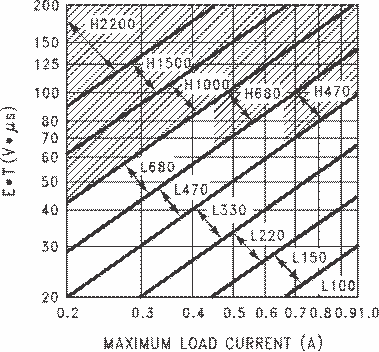 Figure 12. LM2575 Inductor Selection
Figure 12. LM2575 Inductor Selection
8.2.3 Application Curves
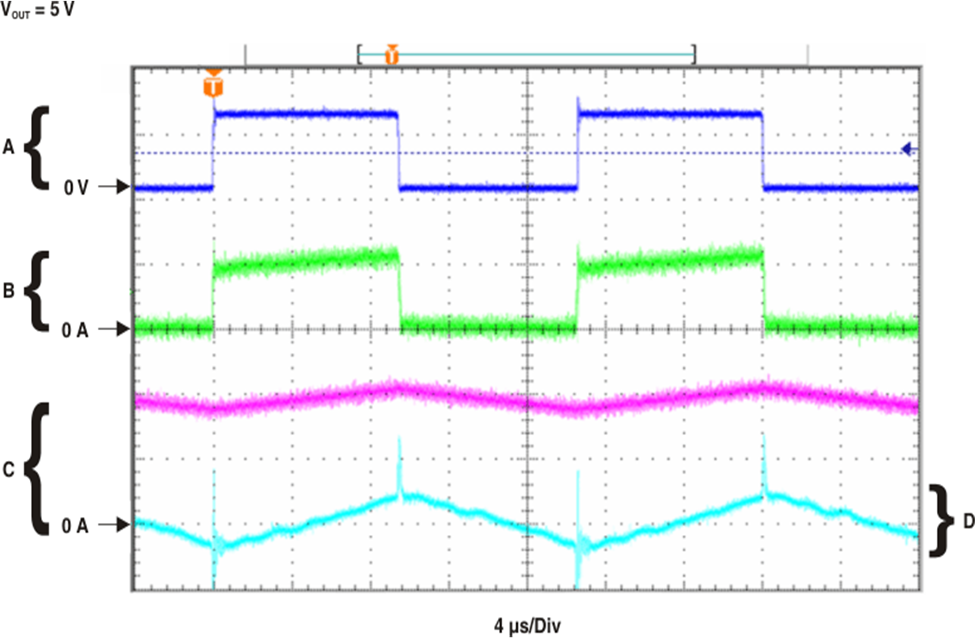
| A. Output pin voltage, 10 V/Div | ||
| B. Output pin current, 1 A/Div | ||
| C. Inductor current, 0.5 A/Div | ||
| D. VOUT ripple voltage, 20 mV/Div |
